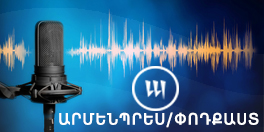Azerbaijani embassy manipulates Lithuania’s Parliament in failed propaganda attempt
 15:54, 21 February 2017
15:54, 21 February 2017YEREVAN, FEBRUARY 21, ARMENPRESS. The Armenian community of Lithuania foiled another propaganda event of Azerbaijan. The Embassy of Azerbaijan in Lithuania has sent invitations to the diplomatic corps and Lithuanian politicians for a concert dedicated to the so-called “25th Anniversary of Khojaly genocide”, scheduled for 20th of February in “Vilnius City Hall”, however, as result of efforts of the Armenian community the event was failed, since it was possible to reveal another forgery of the propaganda machine of Azerbaijan. The Azerbaijani Embassy sent the invitations from the name of the Azerbaijan-Lithuania friendship group of Lithuania’s Parliament, however in reality it turned out the members of the group were unaware about this.
The Baltic Armenian Alliance issued an announcement in this regard, which namely said:
“We have learnt with concern that the Embassy of Azerbaijan has sent invitations to diplomatic corps and Lithuanian politicians for a concert dedicated to the so called “25th Anniversary of Khojaly genocide”, scheduled for 20th of February in “Vilnius City Hall” (Ratusa).
The invitations to this event have been sent in the name the Azerbaijan-Lithuania Friendship Group in Seimas [Parliament of Lithuania], and the logo of the Lithuanian Seimas has been used. We sent an inquiry to the Seimas for clarification. We also contacted some Seimas members of the above mentioned group. We have not received yet a written clarification, but from our conversations we understood that the group members had no idea that an invitation had been sent in their name. Moreover, and more disturbingly for the Azerbaijani Embassy, it seems the Seimas had not authorized the use of its logo for this event, either. Thus, cheat and distortion are used to attract to an event which is in itself a fabrication of history, although tragedy did happen back in 1992.
Our concern is primarily not about Azerbaijan’s interpretation of history, but its attempt to drag Lithuanian politicians and diplomatic corps in this one-sided and totally distorted presentation of some episodes of the Nagorno-Karabakh conflict.
It is common practice that some states attempt to represent their own interpretation of recent history thereby emphasizing or ignoring other events in that chain. But it is absolutely unacceptable to spread falsifications and history constructed on those falsifications as undeniable truths. Khojali tragedy, which the Azerbaijan officially claims as “genocide” and pours a lot of money to present its own, even if invented, “genocide” to the international public. There is no genocide scholar who would consider Khojali as “genocide”, since for such terminology the intent, scale, perpetrator and victims need to be clearly identified. Yet, this is not the case here.
Throughout Nagorno-Karabakh conflict, the civilian population was repeatedly exposed to armed attacks, and in some cases, to pogroms and slaughter. Among the most well-known episodes could be mentioned the following: the complete annihilation of Armenian civilian population in the village of Maragha in Nagorno-Karabakh, the ethnic purges of Armenians in Nakhijevan Autonomous Region, in the Azerbaijan SSR, the pogrom and massacre of Armenians in Sumgait (February 26-29, 1988), Kirovabad (November 21-27, 1988), and Baku (January 13-19, 1990), the killings of civilian population in Stepanakert, fired at by facilities “Grad” from Shushi and Khojaly. The 2016 April aggression by Azerbaijan in Karabakh and barbaric killing of civilians (including elderly and children), as well as decapitating of captured or killed Karabakhi Armenian soldiers are a sad attestation of the continuation of fierce mass hatred in Azerbaijan, incited and promoted on the top level.
The question is not whether the events that happened to the population of Khojaly were a tragedy, but of what really happened there, and who is responsible for this tragedy.
In the midst of Karabakh war in 1992 the blockaded Stepanakert, the capital of Nagorno-Karabakh was daily exposed to a relentless artillery fire from the nearby Azerbaijani firing positions. One of these positions was the village of Khojaly, located next to the only airport in the region, capable of providing a link between Karabakh and the outside world. The capture of Khojaly by the Karabakhi Armenian forces was the only way to break the blockade and achieve salvation from the artillery fire, cold and hunger imposed by Azerbaijan to eliminate the people of Nagorno-Karabakh.
Both the authorities and the population of the village had been informed about the upcoming attack and about the existence of the humanitarian corridor for the unhindered exit of the population in the direction of Aghdam controlled by the armed forces of Azerbaijan. Those residents who used this humanitarian corridor were able to reach the Azerbaijani positions. The part of the population which remained in the village did not suffer significant losses during the military operation either and got under the protection of Karabakhi Armenian forces and later on was safely evacuated. The killing of civilians occurred not in the Khojaly and its immediate vicinity, but on the outskirts of Aghdam territory, which were under the control not of Karabakhi, but Azerbaijani armed forces.
[Then] Azerbaijani President Ayaz Mutalibov himself questioned the validity of claims that Armenian stood behind this tragedy. “...the corridor, by which people could escape, had nonetheless been left by the Armenians. So, why did they have to open fire? Especially in the area around Aghdam, where there was sufficient force at that time to get help to the people.” (Ayaz Mutalibov, then President of the Republic of Azerbaijan, “Nezavisimaya Gazeta”, 02.04.1992)
“Khojaly residents themselves insist that they did use the corridor and that the Armenian soldiers, on the other side of the corridor, did not open fire. Some soldiers from the Azerbaijani Popular Front evacuated some of the Khojaly residents in the direction of the village of Nakhijevanik – I have no idea why since it was under the control of the Armenian Askeran Battalion at the time. Others were caught in artillery fire in the area around Aghdam.” (Eynulla Fatullayev, Azerbaijani Journalist, the newspaper “Realny Azerbaijan”, April 2005)
And such evidences of the representatives of Azerbaijan, as well as other countries are sufficient to conclude that the inhabitants of Khojaly had become the victims of power struggle in Baku and are being used for propaganda purposes.
If you are interested to learn more about Aghdam killings we include a booklet as well as request you to visit the website http://xocali.net
Nothing can justify the attempts to use tragedies for the propaganda purposes, especially by the side which is responsible for that.
We appeal to refrain from getting entangled in the Azerbaijani distortion of history. Invented victimization and dehumanization of Armenians, currently underway in Azerbaijan, are not means to support the peaceful resolution of the Nagorno-Karabakh conflict. All our efforts and resources should be directed at building sustainable peace, and not inciting hatred through propaganda.
Baltic-Armenian Alliance “





















